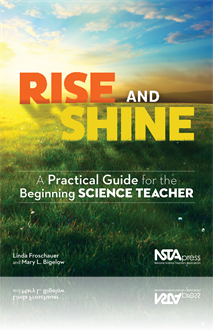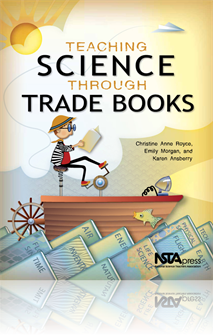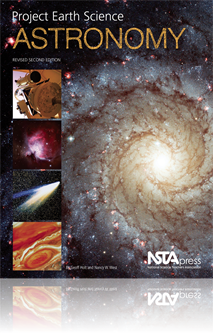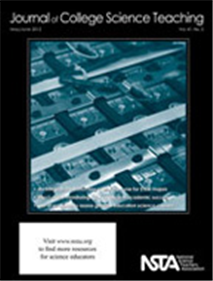All Resources
eBook
Rise and Shine: A Practical Guide for the Beginning Science Teacher (e-book)
Rise and Shine provides a friendly support system that new science teachers can turn to in their first days, months, and even years in the classroom. This easy-to-read book offers plenty of helpful techniques for managing the classroom, maintaining d...
Book Chapter
As a thesaurus of science concepts, The Everyday Science Sourcebook, Revised 2nd Edition: Ideas for Teaching in Elementary and Middle School provides easy access to science activities that teach science concepts that correspond to national standards....
eBook
“This sourcebook was created because science should be memorable, not memorizable.” — from the Introduction to The Everyday Science Sourcebook, Revised 2nd Edition...
NSTA Press Book
Rise and Shine: A Practical Guide for the Beginning Science Teacher
Rise and Shine provides a friendly support system that new science teachers can turn to in their first days, months, and even years in the classroom. This easy-to-read book offers plenty of helpful techniques for managing the classroom, maintaining d...
By Linda Froschauer, Mary L. Bigelow
Book Chapter
As you begin your science teaching career, you will have many questions. The best place to start is to ask questions of yourself. You may not be able to answer all of the questions quickly or casually, but they should be food for thought. Spend time ...
Book Chapter
Although teachers have a huge influence on students, no one can have the effect on students that parents can. No matter the student’s age, the approval of parents is a fundamental need of every child and a powerful motivator. Parents can support yo...
Book Chapter
Consider observations by others as opportunities to improve your skills as a teacher. Be proactive in providing your observer with as much information as possible to make their visit productive. Informed comments from an observer can help you identif...
Book Chapter
Even the most competent, professional teacher in the school was once a first-year teacher and faced issues similar to yours. Many of your colleagues will be sympathetic to your struggles and willing to help. Take advantage of their expertise and expe...
Book Chapter
End-Of-Year Activities And Reflections
By spending a little time at the end of the year organizing your materials and reflecting on your experiences as discussed in this chapter, you’ll be ready for the challenges at the beginning of the next year. ...
Book Chapter
Before You Open The Classroom Or Lab Door For Students
No one is going to tell you what to do during the most critical day of school—the first day. You are responsible for creating the atmosphere and tone that your classroom will provide for the entire year and beyond. The expectations, routines, and p...
Book Chapter
. The way you begin the school year will affect everything that occurs in your classroom and with your colleagues for the remainder of the year—and beyond. When you were student teaching, your cooperating teacher had already set the stage for you. ...
Book Chapter
Creating An Environment For Learning
Think of your classroom as an ecosystem—a set of interconnected components such as the classroom itself, the available resources, and the people who inhabit it. When these components are working well together, learning can be a joyous, exciting adv...
Book Chapter
When you were student teaching or doing an internship, your cooperating teacher already had lab routines and rules in place. But now you’re in charge! You must be proactive about student safety during laboratory activities. You can’t claim ignora...
Book Chapter
When you see a purpose in what you do, feel confident, and like what you do, it shows. Students are among those who can immediately read others. They will know if you are eager to get to school each day, if you enjoy what you teach, and if you care a...
Book Chapter
As a teacher, you can threaten, cajole, plead, or reward students into doing what you want, but the ultimate decision about how much to participate is made by the students. This chapter gives many suggestions of new strategies to try to help your stu...
Book Chapter
Student learning is the ultimate goal of everything you do in the classroom. Assessment is the process of gathering information (or evidence) from a variety of sources to determine what students are learning in terms of knowledge and skills and how t...
Book Chapter
Creating Professional Development Opportunities
Even if your school does not require one, it’s important for you to have your own plan for continuing education. You can begin by generating a list of what you want to learn. Perhaps it is science-related content, or maybe it’s a teaching strateg...
Book Chapter
When students think of cold weather, they often think of mittens, snowflakes, and penguins! In this chapter, celebrate those tuxedo-clad birds that have come to symbolize winter and provides students with the opportunity to investigate adaptations th...
Book Chapter
Earth is an extremely complex system with many components and subsystems, and they all interact and affect each other. The four major subsystems are atmosphere (air), lithosphere (land), hydrosphere (water), and biosphere (life). A change in one part...
Book Chapter
Global warming is happening now, and scientists have evidence that humans are to blame. The rate of warming in the past 50 years has doubled, and temperatures are certain to go up even more. To gain an understanding of how global warming might impact...
Journal Article
Self-Monitoring Tools and Student Academic Success: When Perception Matches Reality
This study investigates the effectiveness of use of self-assessment and post-exam reflection forms as cognitive feedback and additional self-regulated learning strategies students can use to achieve a positive outcome on exams....
Journal Article
This column shares reflections or thoughtful opinions on issues of broad interest to the community. This month’s issue discusses the importance of physiology education....
Journal Article
The authors implemented peer instruction in an introductory level conceptual physics course for nonscience majors and found no correlation with course grade. They did notice moderate correlation between answering a conceptual question correctly prior...
Journal Article
A Case of Reform: The Undergraduate Research Collaboratives
In this report the authors include brief descriptions of five undergraduate research collaboratives and discuss their common components and the variety of implementation strategies. They also examine the impacts of early research on students, faculty...
Journal Article
Personal Response Systems and Learning: It Is the Pedagogy That Matters, Not the Technology
This study investigated whether using clickers in conjunction with lecture tutorials yields higher student learning gains than using only lecture tutorials. The results suggest that the clickers do not lead to additional learning gains....
Journal Article
Case Study: Resistance Is Futile ... or Is it? The Immunity System and HIV Infection
This column provides original articles on innovations in case study teaching, assessment of the method, as well as case studies with teaching notes. In this month’s issue the case study uses an interrupted progressive disclosure format, during whic...
Journal Article
This article describes the mobilization, planning, and implementation of a first-year interdiciplinary course for STEM majors that integrates key concepts found in traditional first-semester biology, chemistry, computer science, mathematics, and phys...








